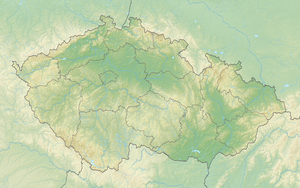Loket Castle
| Loket Castle | ||
|---|---|---|
| Place: | Loket | |
| Geographical location | 50 ° 11 '10 " N , 12 ° 45' 15" E | |
|
|
||
The Loket Castle (Czech Hrad Loket , German Castle Elbogen) is in Loket in Sokolov District in the Czech Republic .
history
On a granite hill within an almost circular loop of the Eger river , the town of Loket and the castle of the same name dominate the landscape. The oldest buildings date from the 13th century.
Archaeological excavations brought finds from the second half of the 12th century to light. The Bohemian Prince Vladislav II or Ministeriale of Emperor Frederick I Barbarossas are believed to be the builder . After 1300 the castle complex was expanded to include a lower castle and expanded continuously until the 1520s; it therefore shows stylistic features from the Romanesque and Gothic periods .
Elbogen Castle was first mentioned in a document from 1234 as the seat of a castle administration in the southern wing. The extensive residential buildings in the northern part, as well as the margrave house, were built in the early 14th century. It was of strategic importance for the rule over Bohemia .
King Wenzel I from the Premyslid family and King Conrad IV from the Staufer family met at this border castle to the historic Egerland in the former Nordgau (Bavaria) . Emperor Charles IV from the House of Luxembourg, who was kept here with his mother for a few months as a child, redeemed the royal fortress pledged by his father and elevated the town of Elbogen to the status of a city under Eger law. In 1376 he still held court at Elbogen Castle, as did Wenceslaus IV, who confirmed the town charter of Elbogen and appointed burgraves to manage it. In 1405 Elbogen fell to Albrecht von Kolowrat , five years later to Jan Malerik. Emperor Sigismund, the last Luxembourger, confirmed first as Burgrave Friedrich von Hohenzollern , Burgrave of Nuremberg, Arch Chamberlain of the Holy Roman Empire and later first Elector of Brandenburg, before the castle was pledged to Buda von Ilburg , who successfully protected it against the attacks of the Hussites defended. Emperor Sigismund's financial shortage forced him to hand over the imperial jewelery kept in Hungary to the imperial city of Nuremberg for a thousand marks in silver . In 1437 Emperor Sigismund, obedient to the need, bequeathed the Elbogen pledge to his Chancellor Kaspar Schlick in return for financial support . The Schlick were only able to defend the pledge with the help of Saxon troops against the angry citizens of Elbogen and had extensive renovations carried out on the castle. After a rebellion against the Habsburgs , supported by the Schlick, was put down in 1547 , the family also lost Elbogen Castle in confiscations. This came temporarily as pledge to the Lords of Plauen and then reverted to the Crown of Bohemia . In 1607 Georg Popel von Lobkowicz died there as a prisoner of Emperor Rudolf II von Habsburg.
In the Thirty Years' War (1618–1648) the castle in Elbogen began to fall into disrepair; it was occupied one after the other by insurgents, the Bavarians, the Saxons and the mercenary troops from Wallenstein . Only the Swedes could she resist in 1646.
After the economic recovery of the city of Elbogen in the 17th century, the castle lost its political importance. It was used as a warehouse and after 1822 it was also a state prison. After a fire at the end of the 18th century, the restoration of the castle began at the beginning of the Romantic Age .
After the First World War and the establishment of Czechoslovakia in 1919, Elbogen Castle came under the management of the Pilsen Monument Office; from 1939 to 1945 it was in the Reichsgau Sudetenland . At the end of the Second World War, at the end of May 1945, the town and Elbogen Castle were occupied by American troops coming from Eger until they were handed over to Russian-Soviet troops. At the end of 1993, after the founding of the Czech Republic , it passed into the administration of the town of Loket . Today a museum has been set up in parts of the castle, which shows valuable porcelain (brand: an armored arm with sword) from the 19th century, produced by the porcelain factory Gebrüder Haidinger in Elbogen u. a. under the administration of the brothers Rudolf Haidinger (1792–1866) and Wilhelm von Haidinger (1797–1871). There are also rooms available for public events.
Personalities
- Georg Popel von Lobkowicz was held at Loket Castle for treason against Emperor Rudolf II (HRR) von Habsburg until his death in 1607, presumably due to heart failure .
literature
- Hans-Ulrich Engel: Castles and palaces in Bohemia. Based on old templates (= castles, palaces, mansions. Vol. 17). 2nd Edition. Weidlich, Frankfurt am Main 1978, ISBN 3-8035-8013-7 , pp. 120–121, illustration p. 242.
- Vinzenz Uhl: Castles and palaces of the Ore Mountains and Egertal. Kaaden, 1935.
Trivia
- Loket Castle was the location of "Montenegro" in the James Bond movie James Bond 007: Casino Royale starring Daniel Craig .
Web links
- Homepage of the castle
- Loket Castle on the city website
- Loket Castle on Burgenwelt.org



